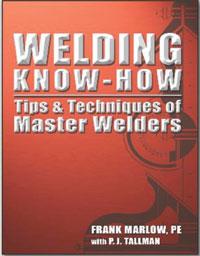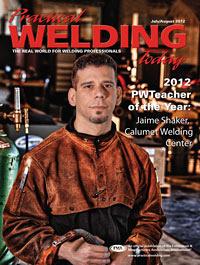- FMA
- The Fabricator
- FABTECH
- Canadian Metalworking
Categories
- Additive Manufacturing
- Aluminum Welding
- Arc Welding
- Assembly and Joining
- Automation and Robotics
- Bending and Forming
- Consumables
- Cutting and Weld Prep
- Electric Vehicles
- En Español
- Finishing
- Hydroforming
- Laser Cutting
- Laser Welding
- Machining
- Manufacturing Software
- Materials Handling
- Metals/Materials
- Oxyfuel Cutting
- Plasma Cutting
- Power Tools
- Punching and Other Holemaking
- Roll Forming
- Safety
- Sawing
- Shearing
- Shop Management
- Testing and Measuring
- Tube and Pipe Fabrication
- Tube and Pipe Production
- Waterjet Cutting
Industry Directory
Webcasts
Podcasts
FAB 40
Advertise
Subscribe
Account Login
Search
Welding fascination leads to spinoff writing career
Frank Marlow, author of Welding Know-How: Tips & Techniques of Master Welders shares his motivations for writing about welding
- By Amanda Carlson
- July 23, 2012
- Article
- Arc Welding
Twelve years ago Frank Marlow, a retired registered professional engineer and current president of Metal Arts Press, Huntington Beach, Calif., was looking for a book that did more than just rehash welding theory. He wanted to know the little tips and tricks that you can learn only from experienced welders themselves. When he couldn’t find such a book, he decided to go out and write his own.
Welding Know-How, Marlow’s fourth published work, is not your ordinary welding overview. While it does include basic information on the various welding and industrial cutting methods like many other welding textbooks do, it also includes DIY tutorials on things like removing a stuck steel bearing, removing a rusted nut, or repairing punctured aluminum tubing, just to name a few. Other topics discussed are metallurgy, distortion control, and component design.
Marlow recently sat down with Practical Welding Today® to discuss his new book, Welding Know-How: Tips & Techniques of Master Welders, which was released in March.
Q: What compelled you to write a book about welding?
A: I was an electrical engineer and I worked in a variety of sales, marketing, and product development jobs in my career. No matter where my career took me, I never really lost my love for technology and circuit design.
After I retired I went to Orange Coast College, Costa Mesa, Calif., in 1995 and started taking welding courses. I’d always been interested in welding, but I’d never been trained. As I took the course I realized there were a lot of things that I didn’t know that weren’t in the textbook and that were not discussed by the instructor. I was a very serious student while I was in welding school. I read and studied the textbooks in detail and found they were disjointed and a lot of the pictures were filler. They had very limited relationship to the text. There are a couple of exceptions, of course—there are a few really outstanding textbooks—but in general these types of books are not written from the perspective of a skilled craftsman. So I thought, you know, I’m not a writer, but I think I can do a little bit better. I made friends with some folks who knew a great deal more than I did about welding and machine shop work, and that really launched me into the book writing business.
We produced our first book, Welding Essentials, in 2000. It took roughly two years from start to finish. We sold it to a major industrial publisher in New York and it sold right away, probably because there aren’t a whole lot of people that write on the subject. Welders don’t write and writers don’t weld.
Q: How is Welding Know-How different from your first book?
A: It’s 50 pages longer, it’s a lot more dense, it has a lot more material in it, and it benefits from my having learned a lot in 12 years since the first one. And that’s not an understatement.
Q: What have you learned?
A: Welding has a lot of facets, and what I have learned is that it can give you a tremendous amount of options when you’re in a machine shop. I learned how powerful it is to have the option of welding and cutting in a machine shop. Most people think of welding for construction, I-beam welding, and the amateurs are always making lawn ornaments or trailers. Those are popular projects. They don’t usually think of using welding in a machine shop. That was an eye-opener. I came to find out that people I knew were very good at integrating welding within their machine shop work.
Nowadays people will approach a machine shop with a broken part and the company they’ve purchased it from is out of business, so they can’t get another one. You have to figure out how to make this part. Sometimes the part simply can be repaired by adding metal to it and reshaping it. For example, somebody came into my friend’s shop with a housing from a 1912 automobile. It was one of a kind and no replacement part was available. So he added metal to it, shaped it, filed it, ground it, and it’s as good as new. It’s very common. Gears break and welding is a beautiful way to fix them.
I also learned that there are a lot of things that are not documented well. There are very few secrets in this business but there’s a lot of know-how, and the only way people are introduced to that is by working with experienced people in a shop.
Q: What’s next for you?
A: I plan on doing another welding book that will cover more in the way of projects and techniques. All the good stuff—the basic stuff like MIG and TIG—are well-covered, but there are always things that experienced people can do, like making a fixture, for example, or a repair that was clever and might not be obvious. I’d like to get them into print because a lot of the people with these experiences are leaving us.
About the Author

Amanda Carlson
2135 Point Blvd
Elgin, IL 60123
815-227-8260
Amanda Carlson was named as the editor for The WELDER in January 2017. She is responsible for coordinating and writing or editing all of the magazine’s editorial content. Before joining The WELDER, Amanda was a news editor for two years, coordinating and editing all product and industry news items for several publications and thefabricator.com.
About the Publication
Related Companies
subscribe now

The Welder, formerly known as Practical Welding Today, is a showcase of the real people who make the products we use and work with every day. This magazine has served the welding community in North America well for more than 20 years.
start your free subscription- Stay connected from anywhere

Easily access valuable industry resources now with full access to the digital edition of The Fabricator.

Easily access valuable industry resources now with full access to the digital edition of The Welder.

Easily access valuable industry resources now with full access to the digital edition of The Tube and Pipe Journal.
- Podcasting
- Podcast:
- The Fabricator Podcast
- Published:
- 04/16/2024
- Running Time:
- 63:29
In this episode of The Fabricator Podcast, Caleb Chamberlain, co-founder and CEO of OSH Cut, discusses his company’s...
- Industry Events
16th Annual Safety Conference
- April 30 - May 1, 2024
- Elgin,
Pipe and Tube Conference
- May 21 - 22, 2024
- Omaha, NE
World-Class Roll Forming Workshop
- June 5 - 6, 2024
- Louisville, KY
Advanced Laser Application Workshop
- June 25 - 27, 2024
- Novi, MI
































